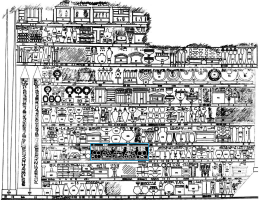

There are several possibilities when considering the glass trade. Trade in:
There is evidence of objects and coloured ingots being transported, e.g. Uluburun shipwreck (Jackson and Nicholson 2010) but, so far, no colourless ingots (which fits well with the dearth of colourless glass prior to the mid-1st millennium) implying that glass was pre-coloured before being transported. Since silica and fluxes were readily available in Egypt and the Near East, the colourant was potentially the more valuable commodity, which could suggest that it was the colourant that travelled and was added to locally derived base glass or its precursors before the ingots were transported.
In addition to Varberg et al.'s work (2015; 2016) there are some indications that coloured glass travelled to Egypt. The Hall of the Annals at the Temple at Karnak, in Thebes, has a scene on one wall depicting Thutmosis III's spoils from his successful campaigns in the Levant and Syria, including gold, silver and glass (Sherratt and Sherratt 1991), with glass referred to as 'stones of casting' in the Amarna letters. Three baskets are dark blue and their contents are depicted in two forms: one basket has five round objects, the other two are baskets of irregularly shaped lumps. The round objects appear human-made and are potentially dark blue glass ingots (Shortland 2012, 140-45). Although one of the baskets with irregularly shaped lumps could be lapis lazuli, the second is denoted differently, which suggests that it is not lapis lazuli but is also dark-blue glass (Figure 1).


Mycenaean blue glass was analysed in the 1970s using neutron activation analysis (NAA), indicating the Western Egyptian Desert as the origin for cobalt (Sayre and Smith 1974, 47-70). Nikita and Henderson (2006), examining a larger sample, identified five additional cobalt compositional groups based on manganese, nickel and zinc levels as well as the presence or absence of the volatile arsenic, which they attributed to additional cobalt sources. According to Shortland (2012) these new groups may be a consequence of the detection limits of their microprobe analysis, a view supported by the LA-ICPMS (laser ablation inductively coupled plasma mass spectrometry) work of Walton et al. (2009), which showed that (for the cobalt Mycenaean glass they analysed) the Western Egyptian Desert was the most likely origin for cobalt, with trace elements of chromium and lanthanum, which are not colour-derived but derive from the base glass raw materials, supporting an Egyptian source (Shortland et al. 2007).
LBA and early Iron Age cobalt glass beads with elevated levels of alumina, nickel, manganese and zinc have been found in France, again suggesting an Egyptian Western Desert origin (Gratuze 2006). This is interesting as the later Iron Age glass was being made when the Egyptian oases sources were no longer being used. A similar conundrum can be found in Iron Age Nimrud and Kaman-Kalehöyük in Turkey, where cobalt-blue glasses have been found that appear to have been made with cobalt alum from Egypt much later than when it was being exploited in Egypt (Brill 1999; Henderson et al. 2018). This perhaps suggests another, as yet undiscovered, cobalt source with similar composition to that of the Western Desert oases. Furthermore, the absence of cobalt-blue glass is notable at the late New Kingdom site of Lisht in Egypt (Smirnou et al. 2018).
Gratuze (2013) outlined the main chemical associations with cobalt pigments used in glass and glaze production in Western Europe and Mediterranean regions from the Bronze Age through to the 18th century AD. However, as with many of the provenance studies, there is a reliance on compositional anchors that rarely connect objects to specific mineral deposits, but generally associate objects with other objects that have been assumed to derive from specific mineral deposits. For example, the discovery of 175 glass ingots in the cargo of a late 14th century BC shipwreck off Uluburun, Turkey, suggests trade in glass. Their shape and size have clear parallels with Egyptian production sites, indicating that glass was being transported from Egypt to Mycenaean Greece. However, although the presence of cobalt-blue glass on board the Uluburun vessel is generally taken to be evidence of Egyptian provenance, this is based on the fact that these ingots have similar composition to Egyptian and Mycenaean cobalt-blue glass. Therefore, unless it can be shown with certainty that cobalt in cobalt-blue Egyptian glass comes from Egypt, thereby implicating an Egyptian source at least for the colourant, the similarity in chemical composition between cobalt-blue glass from Egypt and the Uluburun shipwreck points to a common, but not necessarily an Egyptian, origin. Another complicating factor is that different compositional signatures could also be a consequence of recycling.
Internet Archaeology is an open access journal based in the Department of Archaeology, University of York. Except where otherwise noted, content from this work may be used under the terms of the Creative Commons Attribution 3.0 (CC BY) Unported licence, which permits unrestricted use, distribution, and reproduction in any medium, provided that attribution to the author(s), the title of the work, the Internet Archaeology journal and the relevant URL/DOI are given.
Terms and Conditions | Legal Statements | Privacy Policy | Cookies Policy | Citing Internet Archaeology
Internet Archaeology content is preserved for the long term with the Archaeology Data Service. Help sustain and support open access publication by donating to our Open Access Archaeology Fund.